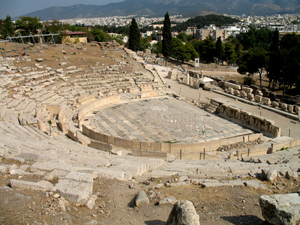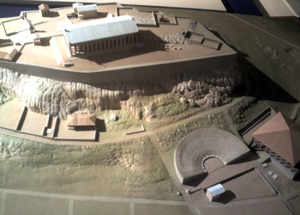
dithyrambic chorus
The Beginnings
of Greek Theatre

cup with picture of Dionysos
In the middle of the 6th century BC (550ish) a town near Athens, Eleutherae, became part of the Athenian empire. They had a cult of the god Dionysos (the god of wine and joy), and the cult was moved to Athens.
The wooden statue of Dionysos was brought in a holy procession to a small temple just to the south of the Acropolis.
The remains of this temple are to the right of the picture shown here.
The picture right is a model, showing where the theatre was, just below the Acropolis.

Theatre of Dionysos today

The Dionysia
Each year after that a festival of Dionysos (the Dionysia) was celebrated. Young men would dress as satyrs (half men, half goats), wearing masks. Animals were led through the streets to be sacrificed to Dionysos, while people sang hymns to the god, danced, and played musical instruments. These special songs for Dionysos were called dithyrambs, and the group of 12 or 15 singers and dancers, accompanied by flute players, was called a chorus (see above left). In the agora (the market place) the chorus would act out ritual scenes to do with Dionysos. This is how theatre began.
Writing
Another reason plays were invented is that Greeks started writing. They invented their alphabet about 600 BC, and this allowed them to write down plays. Now, a playwright could write down an exact set of words, and an actor could memorise them by reading them. Before, story tellers would sing their stories and others would have to learn just by listening. This was very hard to do so stories kept changing as people forgot some bits and added others.
In 534BC, an actor called Thespis began talking to the chorus as part of the ritual scenes. We call this a dialogue (Greek for two people talking). This was the beginning of Greek drama. Also we get the word 'thespian', which means an actor, from the name Thespis.
Eventually the performances, or plays, were written specially by playwrights, and were entered into a competition.

Reconstruction of Theatre of Dionysos
The Theatre of Dionysos
By the 5th century the performances moved to the south slope of the Acropolis, next to the temple of Dionysos. The slope made a natural seating place for the public. Wooden seats were made and later a wooden stage, with a round area in front called the orchestra, where the chorus stood.
This was the Theatre of Dionysos - the first proper theatre in the world. In the 4th century it was converted to stone, and could hold up to 14,000 people (see picture, left).
Dionysos at the Eden Project
The pictures show a metal sculpture at the Eden Project. The bull represents Dionysos and the other figures are maenads, the women who worshipped him.

 .
.
Maenads would run through the woods in ecstasy, playing music, and tearing apart wild animals and eating them raw. All of this is described in Euripides' play, The Bacchae.
The sculptures are in a field of vines, which is appropriate as Dionysos was the god of wine.